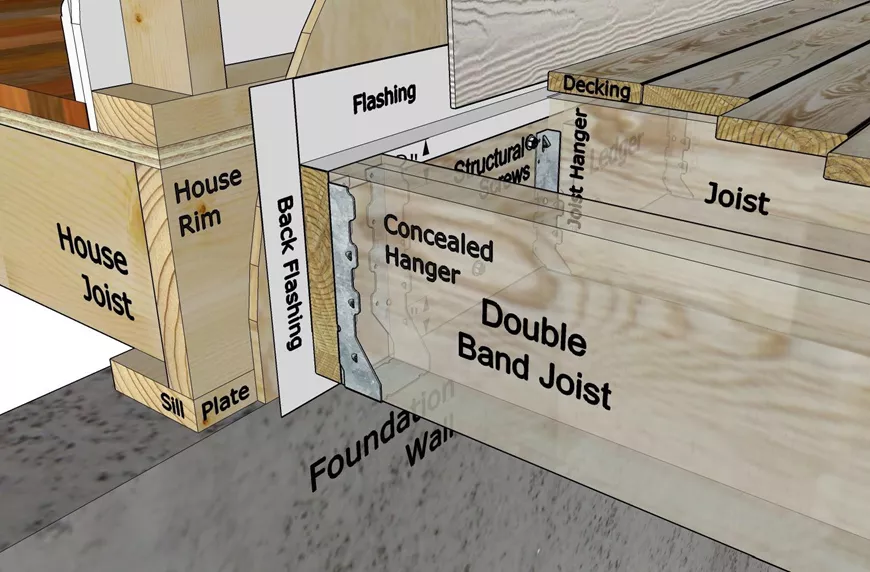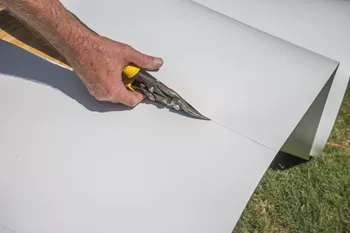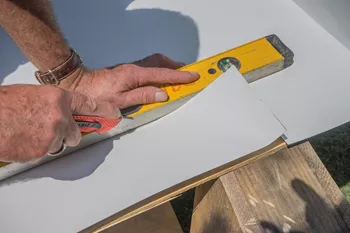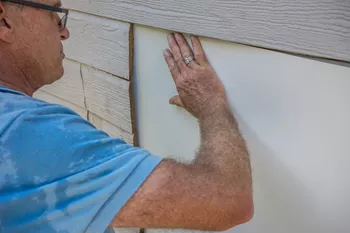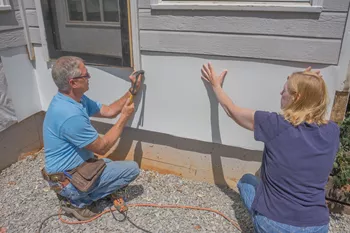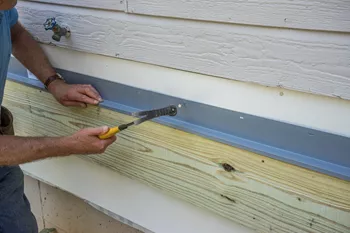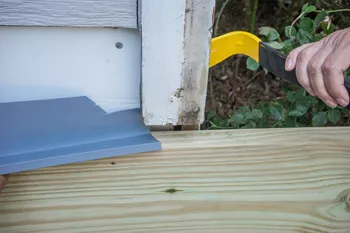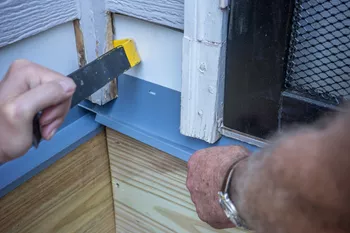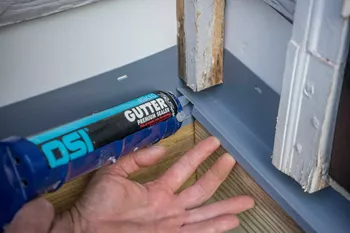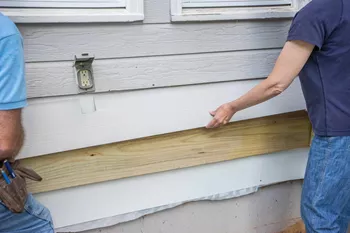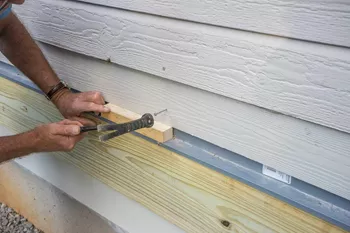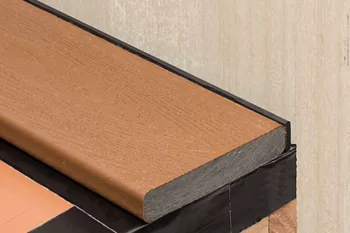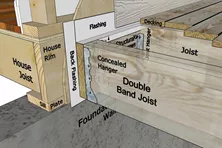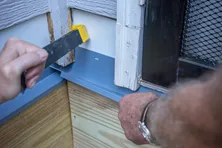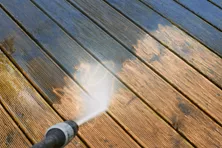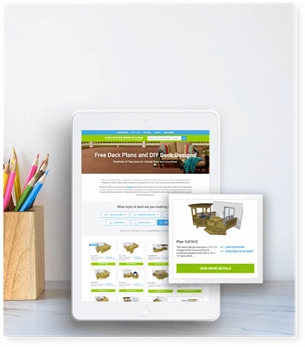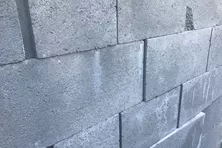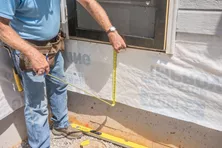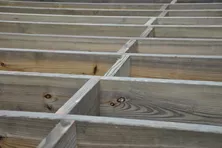How to Flash a Deck Ledger Board
If you cut out your siding to install a ledger board, careful steps must be taken to ensure that moisture cannot reach your house. Infiltrating rainwater can travel downward, sideways and even upward, so special flashings must be used. In the past, metal flashing and extra layers of roofing felt (tar paper) were often used, but nowadays, vinyl “Z” flashing and rolls of vinyl back flashing do a better job.
Ideally, the house’s sheathing should be triple protected from moisture - with building paper or roofing felt stapled to the sheathing; then with back flashing; and then the Z flashing, which also protects the ledger itself.
The deck flashing configuration shown in this article is quite common. However, your codes may call for other methods, so check with your building department before you start work. For instance, some inspectors may prefer self-adhering flashing (which is much the same as self-stick ice and water shield often used at roof eaves) instead of vinyl back flashing.
It's dangerous whenever using a razor knife. Be sure to clamp a straight edge to the surface to ensure a straight line. This is just a score, not a cut. You do not want to cut through the flashing. Cutting halfway through will allow it to bend very easily.
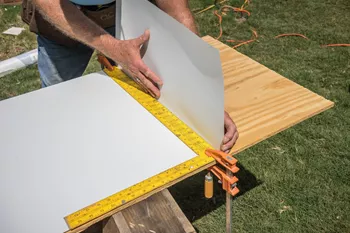
In this example, we used back flashing that is as wide as the exposed building paper, plus 3". Mark for cutting to length with a square and pencil, and cut with tin snips. To make a bend at an inside corner, clamp a straight edge onto the piece and score with a knife, and bend carefully.
Slip the back flashing under the siding at least 3" at the top and the sides. You may need to pry out siding first. If nails are in the way, pull them out. Pry the siding out near a nail, then push the pry bar against the nail as you partially tap the siding back in. That should pop the nail head out far enough so you can pry it out. Take care not to tear the building paper or tar paper while you do this. Attach the back flashing with as few nails as necessary to keep it lying flat.
[TIP]
At this point, you will need to go to here to cut and attach the ledger. Then, come back and install the Z flashing.
[Tip] When nailing your vinyl Z flashing to the house, be sure to nail every 12" along the house with roofing nails. The nails should not be nailed tight to the flashing. You should allow the flashing to move from side to side in the slotted hole provided. Do not notch the flashing around joists.
At an inside corner, slide the first piece in so its bottom lip slips in between the two boards. (If the boards are too tight and you cannot do that, cut the lip to fit.) Snip a notch out of the second piece as shown, and slip it into place. If the second piece cannot sit flat, you may need to cut the notch a bit larger.
To keep water and ice from building up between the first deck board and the flashing, use an EPDM foam, such as Trex RainEscape Wall Flash.
Attaching the Ledger Board to the House Rim
Learn how to properly install a waterproof ledger board using flashing and fasteners. Check out our step-by-step video and detail drawings.
Installing A Ledger Board Around A Corner
Follow our tips to properly install a deck ledger board around the corner of a house to keep water out.
Types of Deck Flashing
Compare stainless steel, copper and vinyl flashing materials for waterproofing your deck ledger board.
How to Prepare & Protect Your Deck for Winter
Preparing and protecting your deck for the cold weather is important to ensure the longevity of your deck, especially in cold climates. Learn how to prepare your deck for winter at Decks.com.
How to Restore & Refinish a Deck
Decks need maintenance. A twice-yearly cleaning is needed at a minimum. But wood decks—even with good upkeep—can still warp, rot, or get termites. Plus, no stain or paint job lasts forever. Fortunately, you can reset the clock by restoring your deck and refinishing it.
More Helpful Resources
Explore Articles by Topic

Footings
Information related to installing frost footings for decks

Framing
Learn structural framing methods

Decking
Learn about wood and composite decking materials

Stairs
An in-depth look at the complex issue of how to build stairs

Railings
How to install guardrails and handrails to meet IRC code

Features
An overview on water drainage, benches, planters and lights

Design
The basics of deck design

Planning
Learn about permits and working with contractors

Porches & Patios
Build a covered deck to enjoy all seasons

Ledger
Proper attachment techniques

Care
Maintain your deck to maintain your investment

Materials
An overview on water drainage, benches, planters and lights
Attaching the ledger board to hollow block
Our inspector discusses how to attach a deck to a hollow concrete block foundation wall.
Attaching the Ledger Board to the House Rim
Learn how to properly install a waterproof ledger board using flashing and fasteners. Check out our step-by-step video and detail drawings.
Removing the Siding
Learn the right way to remove vinyl siding for ledger board installation—without damaging your home’s exterior. Step-by-step guide with pro tips!
How to Remove Scuffs and Scratches from Composite Decking
Removing scuffs and scratches can help make your composite deck look like new. Learn how to fix and prevent your composite deck from future scratches.
Best Deck Cleaner Options
Discover the best deck cleaning and brightening solutions for composite decks, wood decks, and more. Learn how to remove dirt, mildew, and algae with Decks.com.
How to Avoid, Prevent & Repair Deck Joist Rot
Rotted deck joists can cause homeowners headaches. Learn more about how to avoid, prevent and repair deck joist rot at Decks.com.
Explore Articles by Topic

Footings
Information related to installing frost footings for decks

Framing
Learn structural framing methods

Decking
Learn about wood and composite decking materials

Stairs
An in-depth look at the complex issue of how to build stairs

Railings
How to install guardrails and handrails to meet IRC code

Features
An overview on water drainage, benches, planters and lights

Design
The basics of deck design

Planning
Learn about permits and working with contractors

Porches & Patios
Build a covered deck to enjoy all seasons

Ledger
Proper attachment techniques

Care
Maintain your deck to maintain your investment

Materials
An overview on water drainage, benches, planters and lights




